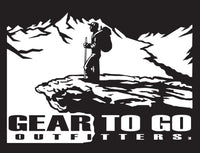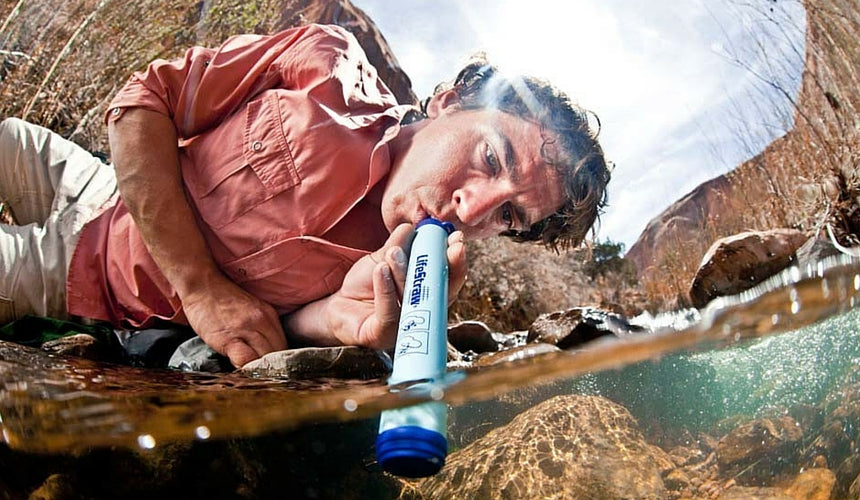You can rack up quite a thirst while hiking, but you don’t want to be drinking water out in the woods without doctoring it up some. Yes, the good old boys in the old Westerns used to sip from the creek when thirsty (unless of course there was a skull nearby), but like a lot of movie stuff, don’t try that at home – or at camp.
Today’s natural water sources are nearly always home to such invisible characters like Giardia lamblia, Cryptosporidium, and other nasty “bugs”. Generally, these protozoa and bacteria and viruses won’t kill you, but just make you wish you were dead before they run their course – run being the operative word here. Where’d these nasties come from? The worst come from mostly other people, or rather their feces to be more exact, but animal feces cause problems too – so sipping from the creek 100 years ago was still a risky proposition.
So what to do? If you can’t carry all the water you need from home or known potable source – like off the shelf at Kroger’s – here are some options.
Boiling works – just bringing a pot of water to rolling boil will wipe out everything you’d need to worry about as far as bacteria and viruses (boil longer at higher elevations), but does little for mud or chemicals in the water. Now you have hot muddy water, but drinkable.
Water filters – filters designed for backwoods use will take out most bacteria and chemicals, but not viruses – they’re too small for most filters to catch. Although viruses are generally the cause of traveler’s diarrhea – Montezuma’s Revenge, etc – in other countries, they are not considered that much of a threat in most North American wilderness areas. That threat seems to be increasing though, particularly in high-use camping areas.
Add treatment solutions – chlorine, if you use enough of it for long enough, will kill bacteria and viruses, but not do anything for chemicals and sediment and maybe not all protozoa. Iodine works like that as well, but may offer limited protection against Cryptosporidium. And either makes the water taste somewhere between the flavor of a public swimming pool and some first aid ointment.
Most of the time, in most cases, in most hiking areas – catch that loophole? – a good water filter is all you need. Drop the inlet hose into the water source, pump away on the handle, and let the water from the outlet hose go into your water bladder or other container. It’s pretty safe to drink then.
If you want to go from “pretty safe” to “real safe”, invest in a few drops or tablets of chlorine-based treatment solution to wipe out anything that’s left. Add a few drops or a tablet shake, and let it sit for about 20 minutes or more to work its magic. Household bleach has the same basic ingredients, but the concentration levels are way out of whack compared to the stuff specifically designed for hiking-related water treatment.
We suggest the filter and chlorine route. We carry very popular water filters from Katadyn and MSR that have a long proven history of effectiveness. For added safety, you can add chlorine treatments from various brands.
Tips On Treatment
Water filters are like a vacuum cleaner – they get clogged if you don’t clean them. Most of the filters we carry have a replaceable element that we keep track of – unless you’re pumping many, many gallons of water you should not have to worry about clogging a filter from us under normal water conditions. But – muddy water will reduce the cartridge life span. To extend cartridge life, always use the best water source available. In heavy sediment conditions, wrap a coffee filter or bandana around the intake prefilter. Just wrap around the intake bulb with a rubber band. Where possible, place untreated water in a container and wait for sediment to settle out and the water appears clear; then filter from water above the sediment. If the handle becomes very hard to pump, the filter cartridge may have become clogged. As a temporary solution in the field, remove the cartridge and swish it around in water. Do not allow contaminated water to enter the cartridge output barb. This will usually provide enough additional cartridge life to complete your trip.
Another tip we offer may seem counterintuitive – pump your water from still, rather than running sources. Sure, the running creek water looks cool, clear and inviting, but the churning water leaves various nasties suspended within it. Pooled water, on the other hand, gives the chemicals and heavier particles a chance to settle to the bottom – that further reduces the likelihood of something bad getting through to your stomach.
As you pump water, or storing the filter in its bag between loading sessions, be careful not to let the intake filter or water dripping from it contaminate the outlet hose or cap that goes into your water bottle or bladder. If it does, be sure to rinse it off with filtered water before using again. Take a small baggie to wrap around the outlet cap with a rubber band when not in use.
If you use a chlorine-based solution to further purify the water, you can get rid of the chlorine taste – with some carbon-based filters – by running thru the filter again. Also consider adding a citrus mix or Gatorade to the water to mask the chemical taste.
Finally, watch for contamination potential within your water bladder or container between uses or refills. Various bad things can start to grow with just a few drops of stale water left alone for a few days. Let the container air dry completely between uses. Sanitize by soaking in a mixture of water and baking soda or vinegar for several minutes.
How Much Have You Had To Drink?
So if you now have safe water to drink from filtering or other treatment, how much do you need? At home, the average person uses maybe 80 gallons a day, so obviously something has to give when you’re out in the woods. OK, so you’re not flushing or showering, or watering your lawn, or washing your car, but that still leaves a lot of water to account for.
Heat and elevation gain are the biggest consumption variables. On a sharp uphill climb on a hot summer day, you can suck down an easy quart an hour. That’s why you don’t want to be boiling water as a treatment method; it would take forever to get very far. That’s also why you want to make sure you have some reliable water sources along the way when you hike – choose trails and routes that will take you near water at least every now and then so you can reload your water container(s). And try to camp reasonably close to a water source as well. Figure going through at least a gallon a day per person in moderate weather and exertion conditions; up to 2 gallons a day when it’s hot or covering long distances and elevation.
You can carry water on a hike in 16- to 32-ounce bottles of various shapes and sizes on short day hikes, or on longer trips move up to water bladders that will hold up to a gallon of water with drinking tubes you can sip from as you hike.
The water you carry can easily be the heaviest thing on your back, so carry the bag within or on your pack so it is as close as possible to your back and higher up – that helps keep you balanced and puts the heaviest weight where it will cause less strain. If water is reasonably available on your route, a lot of hikers will compromise between frequent refills and weight by carrying around 2 quarts on them at most. But on a long arid trail, you might need to carry 2 gallons when you start out. You also need extra water when hiking at higher elevations to avoid altitude sickness arising from dehydration.
One helpful precaution is to start out your hike fully hydrated. If camping near water, drink a lot before heading out for the day – your body will appreciate it, and it’s that much less you’ll have to filter or carry during the day. We suggest drinking at least a quart or more before starting each day of hiking. I mix that first quart with Gatorade or other supplement to get its added benefits at the start of the day.
How do you know how much water is enough? As a general rule, drink before you become thirsty; it seems the thirst mechanism is behind the body’s actual need for water. It’s somewhat like your car’s red engine light – by the time it comes on, something has already been wrong for awhile. So drink as you go. Also, check out the color of your urine – if it’s clear, you’re probably well hydrated. If dark yellow, and you haven’t recently popped a bunch of pills, it means you need some more water inside you - drink up!


Comments
0 comments